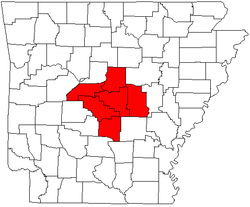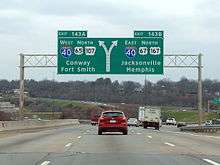Central Arkansas
| Central Arkansas Little Rock-North Little Rock-Conway, AR MSA | |
|---|---|
| Metropolitan Statistical Area | |
|
Downtown Little Rock | |
| Coordinates: 34°44′10″N 92°19′52″W / 34.73611°N 92.33111°WCoordinates: 34°44′10″N 92°19′52″W / 34.73611°N 92.33111°W | |
| Country |
|
| State |
|
| Principal cities |
• Little Rock • North Little Rock • Conway |
| Area | |
| • Urban | 258.3 sq mi (669 km2) |
| • MSA | 4,199 sq mi (10,880 km2) |
| • CSA | 7,326 sq mi (18,970 km2) |
| Population (2016) | |
| • Urban | 431,388 (US: 89th) |
| • MSA | 734,622[1] (US: 76th) |
| • CSA | 905,847[2] (US: 60th) |
| Time zone | CST (UTC-5) |
| • Summer (DST) | CDT (UTC-4) |
| Area code(s) | 501 & 870 |
| Part of a series on |
| Regions of Arkansas |
|---|
 |
|
Geographic Regions |
|
Administrative divisions
|

Central Arkansas, also known as the Little Rock metro, designated by the United States Office of Management and Budget as the Little Rock-North Little Rock-Conway Metropolitan Statistical Area, is the most populous metro area in the US state of Arkansas. It is the core of the broader Little Rock-North Little Rock Combined Statistical Area (CSA). Its economic, cultural, and demographic center is Little Rock, Arkansas's capital and largest city. The Little Rock Combined Statistical area spans ten counties and had an estimated population of 905,847 in 2016.[2]
Geography
Definition

Central Arkansas includes both the Little Rock-North Little Rock-Conway MSA and the broader Little Rock CSA. The MSA is defined by the United States Office of Management and Budget as Faulkner, Grant, Lonoke, Perry, Pulaski and Saline counties. The CSA definition adds the Pine Bluff metropolitan area adding Cleveland, Jefferson, and Lincoln counties, and the Searcy Micropolitan Area, which adds White County.
Prior to 2002, the area consisted of four core counties: Pulaski, Faulkner, Saline and Lonoke. The area was later expanded to include adjoining Perry County to the west, and Grant County to the south. The city of Conway was designated as a third principal city for the MSA by 2007.
Communities
Communities are categorized based on their populations in the 2000 U.S. Census.
Places with more than 100,000 inhabitants
- Little Rock (principal city)
Places with 50,000 to 100,000 inhabitants
- Conway (principal city)
- North Little Rock (principal city)
Places with 10,000 to 50,000 inhabitants
Places with 1,000 to 10,000 inhabitants
Places with 500 to 1,000 inhabitants
|
Places with fewer than 500 inhabitants
|
Population trends
| Year | Metropolitan Statistical Area | Combined Statistical Area |
|---|---|---|
| 2014 est. | 729,135 | 902,443 |
| 2005 est. | 645,706 | 820,846 |
| 2000 Census | 610,518 | 785,024 |
Demographics
2000 Census
MSA
As of the census[3] of 2000, there were 610,518 people, 241,094 households, and 165,405 families residing within the MSA. The racial makeup of the MSA was 75.40% White, 21.02% African American, 0.44% Native American, 0.96% Asian, 0.04% Pacific Islander, 0.87% from other races, and 1.27% from two or more races. Hispanic or Latino of any race were 2.07% of the population.
The median income for a household in the MSA was $37,912, and the median income for a family was $44,572. Males had a median income of $31,670 versus $23,354 for females. The per capita income for the MSA was $18,305.
CSA
As of the census[3] of 2000, there were 785,024 people, 304,335 households, and 210,966 families residing within the CSA. The racial makeup of the CSA was 73.97% White, 22.73% African American, 0.42% Native American, 0.85% Asian, 0.04% Pacific Islander, 0.80% from other races, and 1.20% from two or more races. Hispanic or Latino of any race were 1.93% of the population.
The median income for a household in the CSA was $35,301, and the median income for a family was $41,804. Males had a median income of $31,192 versus $22,347 for females. The per capita income for the CSA was $16,898.
Economy
The Little Rock Regional Chamber of Commerce, the oldest association in Arkansas, has produced the following list of largest employers in Central Arkansas.
| Employer | Number of employees |
|---|---|
| State of Arkansas | 32,200 |
| Local government | 28,800 |
| Federal government | 9,200 |
| University of Arkansas for Medical Sciences | 8,500 |
| Baptist Health | 7,000 |
| Little Rock Air Force Base | 4,500 |
| Acxiom | 4,380 |
| Little Rock School District | 3,500 |
| Central Arkansas Veterans Healthcare System | 3,500 |
| Entergy Arkansas | 2,740 |
| Pulaski County Special School District | 2,700 |
| AT&T | 2,600 |
| CHI St. Vincent Health System | 2,600 |
| Arkansas Children’s Hospital | 2,470 |
| Dillard's | 2,400 |
| Verizon Wireless | 2,000 |
| Union Pacific Railroad | 2,000 |
| Arkansas Blue Cross Blue Shield | 1,800 |
| Dassault Falcon Jet Corp. | 2,000 |
| CenterPoint Energy | 1,800 |
Source: Little Rock Regional Chamber of Commerce
Higher education
Notable colleges and universities
| School | Enrollment | Location | Type | Mascot | Athletic Affiliation (Conference) |
|---|---|---|---|---|---|
 University of Arkansas at Little Rock |
11,848 | Little Rock | Public State University |
Trojans | NCAA Division I (Sun Belt) Non-Football |
 University of Central Arkansas |
11,487 | Conway | Public State University |
Bears and Sugar Bears | NCAA Division I FCS (Southland) |
| Hendrix College |
1,348 | Conway | Private liberal arts college |
Warriors | NCAA Division III (SAA) |
Infrastructure
Major highways



.svg.png) Interstate 30
Interstate 30
.svg.png) Interstate 40
Interstate 40
 U.S. Highway 64
U.S. Highway 64 U.S. Highway 65
U.S. Highway 65 U.S. Highway 67
U.S. Highway 67 U.S. Highway 70
U.S. Highway 70 U.S. Highway 165
U.S. Highway 165 U.S. Highway 167
U.S. Highway 167 U.S. Highway 270
U.S. Highway 270
Aviation

The Clinton National Airport in Little Rock is the largest commercial airport in the state, with more than 100 flights arriving or departing each day and nonstop jet service to eighteen cities.[4] North Little Rock Municipal Airport, located across the Arkansas River, is designated as a general aviation reliever airport for Clinton National by the Federal Aviation Administration (FAA).[5] Central Arkansas also has several smaller municipally owned general aviation airports: Conway Airport at Cantrell Field in Conway, Saline County Regional in Benton, Grider Field in Pine Bluff.
Professional sports

The city of Little Rock is home to the Arkansas Travelers. The Travelers are the AA Minor League Baseball affiliate of the Seattle Mariners. They compete in the Texas League and play their home games at Dickey-Stephens Park.
See also
 Arkansas portal
Arkansas portal- Arkansas metropolitan areas
- Enola earthquake swarm
References
- ↑ "Metropolitan Statistical Area". U.S. Census Bureau. Retrieved July 12, 2017.
- 1 2 "Combined Statistical Area". U.S. Census Bureau. Retrieved July 12, 2017.
- 1 2 "American FactFinder". United States Census Bureau. Archived from the original on 2013-09-11. Retrieved 2008-01-31.
- ↑ "Airport Info - Little Rock". Arkansas Department of Aeronautics. Archived from the original on January 26, 2015. Retrieved January 16, 2015.
- ↑ "Airport Info - North Little Rock". Arkansas Department of Aeronautics. Archived from the original on January 26, 2015. Retrieved January 17, 2015.

